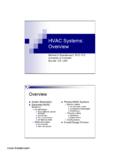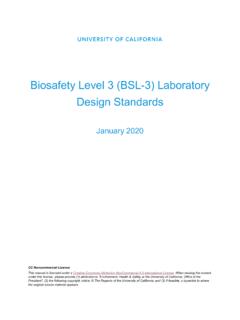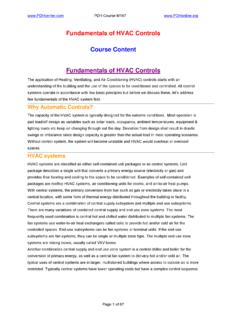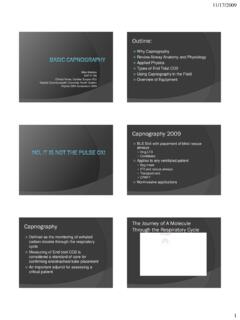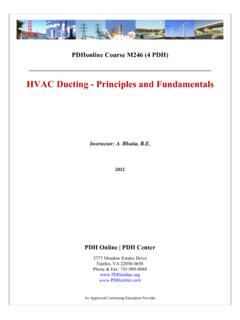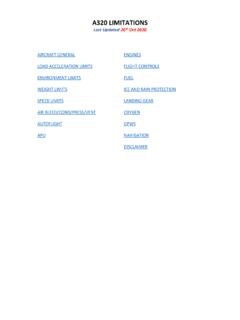Transcription of Potential application of Air Cleaning devices and personal ...
1 2 Potential application of Air Cleaning devices and personal decontamination to manage transmission of COVID-19 SAGE-EMG 4th November 2020 Executive Summary application of air Cleaning devices may be a useful strategy to reduce airborne transmission risks in poorly ventilated spaces (medium confidence). Air Cleaning devices have limited benefit in spaces that are already adequately ventilated, and are not necessary for adequately ventilated buildings unless there are identified specific risks (medium confidence). Air Cleaning devices are not a substitute for ventilation , and should never be used as a reason to reduce ventilation ; all occupied spaces must have some background ventilation to be suitable for human habitation and to comply with building and workplace regulations. ventilation should be assessed, and if possible improved, first before considering whether there is a need to use an air cleaner (high confidence).
2 With respect to the candidate air Cleaning technologies there is some evidence for effectiveness against other coronaviruses, but there is as yet little data that demonstrates the effectiveness of most candidate technologies against SARS-CoV-2. Advice in this paper is therefore based on Potential effectiveness drawn from the known efficacy of devices against other viruses and the principles of virus transmission. Air Cleaning devices where the primary principle of operation is based on fibrous filtration or germicidal UV (UVC) are likely to be beneficial if deployed correctly (medium confidence). These devices are recommended for settings where the ventilation is poor and it is not possible to improve it by other means. The efficacy and safety of such devices should be evidenced by relevant test data. devices based on other technologies (ionisers, plasma, chemical oxidation, photocatalytic oxidation, electrostatic precipitation) have a limited evidence base that demonstrates effectiveness against SARS-CoV-2 and/or may generate undesirable secondary chemical products that could lead to health effects such as respiratory or skin irritation (medium confidence).
3 These devices are therefore not recommended unless their safety and efficacy can be unequivocally and scientifically demonstrated by relevant test data. The use of chemical sprays such as triethylene glycol to clean the air in an occupied space has a limited evidence base in being effective in reducing airborne virus transmission risks, and has Potential health effects for those exposed over a long period of time (medium confidence). These approaches are not recommended without further evidence to support their safety and efficacy. Spray booth type devices for decontaminating people are not recommended. They are unlikely to be effective against the virus and have serious health impact and safety concerns. SARS-CoV-2 transmission is usually through a result of exhaled virus or via the hands, so even where a person who is infected with COVID-19 has passed through a whole-body disinfection system/device, as soon as they breathe, speak, cough or sneeze they can still spread the virus to others (high confidence).
4 Effectiveness of air Cleaning devices depends on multiple parameters including the underlying technology, the design of the device, the in-room location of the device, the environment that it 3 is used in and the maintenance of the device. The performance of most devices is based on data measured in idealised controlled environments, and is likely to be different and often lower in a real-world setting (high confidence). Caution should be used when considering idealised performance data stated by a manufacturer. There may be unintended consequences from the application of air Cleaning devices including emissions that could cause health effects, noise, changes in temperature and drafts. Further, it is clear there is a requirement for regular maintenance and consumable requirements for some devices . In selecting devices it is important to consider all aspects, not just the Potential ability to remove or kill the virus (high confidence).
5 We are unaware of any evidence on how the use of air cleaners might affect people s confidence in and use of environments to mitigate risk of transmission of the virus or other behavioural responses that might undermine the effectiveness of air cleaners such as switching them off or blocking their use in any other way; it would be beneficial to conduct research to understand and anticipate behavioural responses to air cleaners. The range of regulatory processes that may apply to air Cleaning devices are complex and overlapping. Within a class of devices , some are high quality and likely to be effective while some use poor components and poor manufacturing and are ineffective. There are examples of devices which do not meet safety limits on emissions despite claims by the manufacturer. It is recommended that appropriate regulators consider whether there are suitable systems to assess all safety, efficacy and environmental impacts.
6 This may need to be accompanied by action from trading standards, where justified, to remove unsafe or ineffective products. There are a wide variety of devices available on the market with differences in specification and performance, and it is challenging even for those with expertise to select appropriate systems. A number of UK companies seeking to develop or improve upon air Cleaning technologies are small, independently owned enterprises that are struggling to commission validation testing for their equipment. To use air Cleaning devices effectively, urgent action is therefore needed to support industry and consumers in ensuring they are selecting and using devices safely and effectively. This includes: Further research on the efficacy of devices including evidence of the technology against SARS-CoV-2 virus (or a suitable viral surrogate) and other pathogens, performance of devices in real-world settings, and behavioural responses to the use of such devices .
7 Appropriate advice to support the manufacturers of devices and impartial guidance for consumers to allow them to identify appropriate technologies and high quality products and cut through the marketing information on manufacturers websites. Guidance and training for facilities managers and building services practitioners on the selection, design, installation and maintenance of air Cleaning devices . Standards for device testing and approved facilities where industry can access independent and verifiable testing. Alongside microbial testing, there needs to be a specific requirement to measure chemical emissions, by-products and the formation of secondary chemical pollutants, some of which have defined workplace exposure limits, and to demonstrate that these are within permitted levels where they have been identified as potentially harmful. Innovation funding to support the development, verification and deployment of high-quality systems.
8 If well managed this could support UK jobs through growth of a well-regulated industry. 4 Evidence Review Scope and Definitions This paper considers the efficacy and safety of the following strategies for mitigating transmission risks: Portable and fixed room air cleaners designed to be used in occupied spaces: The primary focus is on devices and technologies that impact on the virus in the air. The Potential benefit is therefore in the reduction of the risk of airborne transmission. A small number of technologies are also intended to impact on surface contamination and hence transmission via surface contacts. It is unlikely that any of the air Cleaning devices considered in this paper would be effective at mitigating short range person-to-person transmission because they are generally designed to work in the background and not in close proximity to a person s breathing zone where droplet-based transmission occurs.
9 Spray device technologies to decontaminate people in public spaces: These spray people s bodies, including clothing and hence are intended to target transmission via surface contact only. There will be no effect on airborne or short-range transmission and the disinfectant will have no effect on any virus within an infected person s body. The use of spray chemicals as a strategy for inactivating virus in the air of occupied rooms: This would primarily target airborne transmission but may also act as a surface disinfection method. The following devices and strategies are out of scope: devices within centralised building HVAC systems High energy UV devices ( mobile carousel designs)/chemical airborne disinfection units designed for decontamination of un-occupied rooms Local surface Cleaning devices such as hand held foggers and UV wands personal air Cleaning devices designed to be worn or carried by an individual Within this report we refer to environmental systems as air Cleaning devices .
10 Some research papers and device manufacturers use the terms air purification, air disinfection or air sterilisation. Some documents also refer to such devices as air scrubbers, particularly when used in a dental or healthcare setting. Air Cleaning is considered to be a more appropriate descriptor as it recognises that these devices have the Potential to reduce the bioburden in the air and hence the exposure to infectious virus, however these devices do not lead to sterile environments. Part 1: Device technologies What evidence is there that different device technologies may be effective against SARS-CoV-2 in terms of air Cleaning ? Principles of air Cleaning devices Air- Cleaning technology is being increasingly recommended as a means of improving air quality (Siegel, 2016). A recent online survey of 1,237 people showed that 8% of respondents have purchased a portable air cleaner, purifier or air disinfection device in recent months with the majority quoting COVID-19 as the main motivation for their purchase (OPSS, 2020).











